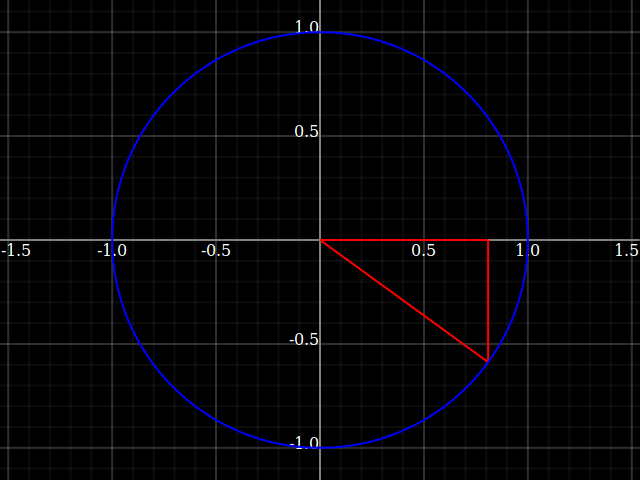Trigonometric functions -- sin - cos - tan - Differences, actual applications,
I always found the trigonometric functions much easier to understand when – despite the name – not approached from the study of arbitrary right triangles, but from unit circles, as can equivalently be done.
(That's not to say this is a better approach – in fact I now consider the triangle definitions geometrically preferrable, as they don't require any length scale or origin – just an easier to understand one.)
You still get triangles in this view, but they're bound into the circle. The picture to keep in mind is this:

What the unit circle accomplishes is, it keeps the hypothenuse always at the value 1. So, in that case the formulas simplify to
$$\begin{align} \sin =& \frac{\text{opposite}}{1} = \text{opposite} \\ \cos =& \frac{\text{adjacent}}{1} = \text{adjacent} \end{align}$$
The tangent formula doesn't simplify, as it doesn't even contain the hypothenuse.
Why do we keep the hypothenuse fixed, and not one of the catheti? Well, let's try what would happen if we did that:

Here, the triangles are not nice and well-constrained in the unit circle anymore, but instead grow to infinity as the angle approaches 90° (or 0°, depending on which cathetus we fix).
That's why the tangent function grows without bound, whereas sine and cosine are smooth and limited to range $[0,1]$ with the only difference being a shift by 90° (corresponding that you switch to the other opposite-ness).
Source code for animations (Haskell with dynamic-plot library):
import Graphics.Dynamic.Plot.R2
import Diagrams.Prelude
main = plotWindow
[ shapePlot $ circle 1 & fcA transparent
, plotLatest [ lineSegPlot [(0,0), (x',0), (x,y), (0,0)]
| φ <- [pi/n, 3*pi/n ..]
, let x = cos φ
y = sin φ
x'= tan φ/y -- use x'=x instead for fixed-hypothenuse
]
, unitAspect ]
where n = 80
There are two fundamentally important results in trigonometry. $$\sin^2(x) +\cos^2(x)\equiv 1$$ $$\tan(x)=\frac{\sin(x)}{\cos(x)}$$
With a right triangle with hypotenuse $1$ and an angle $x$. The base is $\cos x$ and height $\sin x$, or vice versa, and $\tan x$ is their ratio. They are different ratios, but they are connected, and offer other nice properties.
Note also that $\sin(x) =\cos(\frac\pi2-x)$.
An important conclusion from the first statement is that any point on a circle $C$ defined by $(x-a)^2+(y-b)^2=r^2$ can be written uniquely as $(a+r\cos\theta, b+r\sin\theta)$ for some $\theta\in[0,2\pi)$. Lots of geometric and analytical properties use this fact, as well as the entirety of complex number theory being based off it.
Mechanics and Engineering make big use of trig functions too. For example a force hits a plane at an angle, you can use trig functions on that angle to determine the horizontal and vertical components of the force and solve systems in that way.
The most notorious use of $\tan$ that I can think of is the Weierstrass integration substitution, which makes quick work of a lot of integrals. So do the other trig functions, as the special properties they share make them well suited to that sort of thing.
From the definition of trigonometric function, the three expression are equivalent indeed since
$$\cos \left(\frac \pi 2 -x\right)= \sin x$$
we have that
$$\text{opposite}=\text{hypotenuse} \cdot \sin x \implies \text{opposite}=\text{hypotenuse} \cdot \cos \left(\frac \pi 2 -x\right)$$
which, by $y=\left(\frac \pi 2 -x\right)$ leads to
$$\text{adjacent}=\text{hypotenuse} \cdot \cos y $$
The same result can be obtaind from Pythagorean theorem.
For the third one we have
$$\tan x = \frac{\sin x}{\cos x}= \frac{\frac{\text{opposite}}{\text{hypotenuse}}}{\frac{\text{adjacent}}{\text{hypotenuse}}}=\frac{\text{opposite}}{\text{adjacent}}$$
These expression are used for the solution of triangles depending on the information we are given and depending on what we are looking for.
Refer also to the related
- Explanation of SOH CAH TOA